Justice Files
The Ohio Supreme Court has resided in several homes since it first met in 1803, including the Ohio Statehouse and its Judiciary Annex, pictured below and completed in 1901. The justices who’ve walked the Court’s halls each helped to mold the institution’s legal legacy.
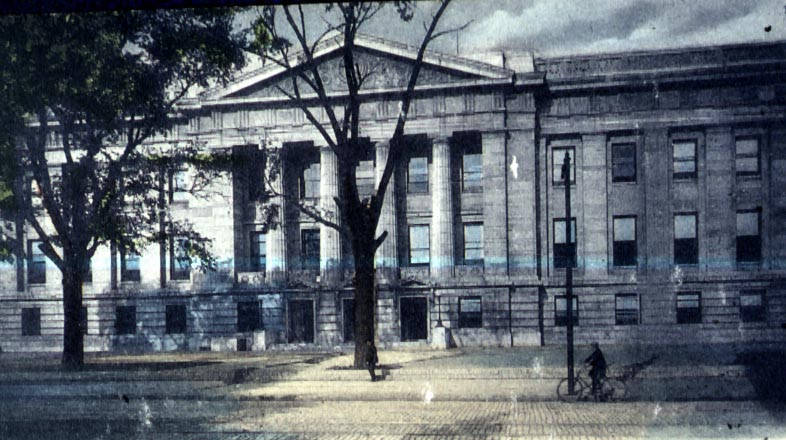
CREDIT: New York: Rotograph Co postcard #H4998.
Ohio has had 159 justices who have devoted their intellect and their time – in one case, a single day; for others, decades – to the state’s court of last resort. Ohio’s first constitution, which Congress made law in 1803, provided that the Ohio House of Representatives and the Ohio Senate, known together as the General Assembly, would select three judges to sit on the new Ohio Supreme Court.
Culling through the rich and varied biographies of the Court’s justices, referred to as judges for well over a century, reveals compelling historical nuggets and important milestones.
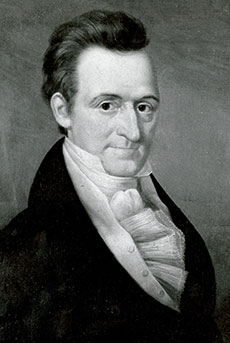
Number One
RETURN JONATHAN MEIGS JR.
Terms: 1803-1804; 1808-1809
Birthplace: Middletown, Connecticut
He was the first. On April 2, 1803, the Ohio Senate and House met and appointed Meigs as “chief judge” of the new Ohio Supreme Court. Following Meigs’ selection, the judges on the Court decided among themselves who would be chief judge for each annual session. Meigs served on the Court the first time until the end of 1804.
On Oct. 13, 1807, Meigs was elected as the state’s fourth governor. However, the General Assembly declared Meigs ineligible to be governor because he hadn’t resided continuously in Ohio for the four years before his election. The legislature then appointed him to fill a new, fourth judgeship on the Supreme Court in early 1808. (The legislature removed the fourth judgeship in 1810, and restored it in 1816.) In December 1808, the legislature elected Meigs to fill a vacancy in the U.S. Senate, and he resigned from the Court.
Court as Comparable Branch of Government. A significant issue before the newly formed state was the power of the courts to declare legislative acts unconstitutional. Meigs, who successfully became governor in 1810, argued the Supreme Court was equal to the Ohio General Assembly as a branch of government.
Items of Note: Meigs County in southeastern Ohio is named after the Court’s first chief judge. His father was a surveyor for the Ohio Company of Associates, the group that founded Marietta in April 1788 as the first permanent settlement in the Northwest Territory.
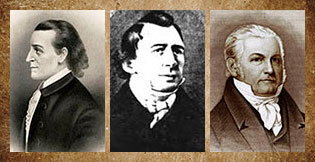
Legislature and Court Battle Over Judicial Review
SAMUEL HUNTINGTON, GEORGE TOD, AND CALVIN PEASE
Huntington’s Term: 1803-1808
Tod’s Term: 1806-1810
Pease’s Term: 1816-1830
These judges helped establish the principle of judicial review, which is a court’s authority to review laws enacted by the General Assembly to decide whether they conflict with the U.S. or Ohio constitutions.
In 1805, the General Assembly enacted a statute defining the duties of justices of the peace and constables. Third Judicial Circuit Judge Calvin Pease determined that part of the law violated the U.S. Constitution. At the Ohio Supreme Court, Judges Samuel Huntington and George Tod agreed in Rutherford v. M’Faddon. Judge Daniel Symmes dissented from the Court’s ruling.
Members of the Ohio House believed that the Court didn’t have the right to find a statute unconstitutional, and they brought impeachment charges against Tod and Pease on Dec. 24, 1808. Huntington had been elected governor a few months earlier, so the House didn’t pursue charges against him.
The Ohio Senate was responsible for handling the trials of Tod and Pease. In front of the assembled senators at the Statehouse in Chillicothe, Tod argued that the Ohio Constitution is the supreme law of the state, subordinate only to the U.S. Constitution and acts of Congress. He also reasoned that the state constitution at times would be improperly subordinate to the General Assembly if legislative acts were binding on the courts without review.
The Ohio Senate acquitted Tod and Pease of the impeachment charges, each by one vote. In 1816, the legislature chose Pease to serve on the Ohio Supreme Court.
Item of Note: A position on the Court at this time meant extended travel under harsh conditions. Without benefit of law libraries in each county seat, the judges couldn’t review prior decisions and formulated their opinions based on their memorized knowledge of the law.
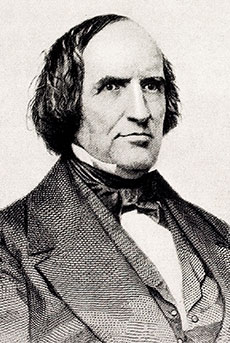
Slavery Addressed by Courts
JOHN MCLEAN
Birthplace: Morris County, New Jersey
Term: 1816-1822
In State v. Carneal (1817), the Ohio Supreme Court considered whether slaves owned by a man traveling in Ohio became free once they entered Ohio and whether a slave who resided in Kentucky could be sent to work in Ohio without gaining his freedom. The 1803 Ohio Constitution forbade slavery in the state. The Court ruled that the slave owner in the case forfeited his right to ownership. Writing for the majority, McLean, whom the legislature selected for the Court in February 1816, stated:
“The abstract principle of slavery is not presented for deliberation in this case. Were it proper to consider it, the Court, as well as from the principles recognized by our Constitution and Laws, could not hesitate in declaring that SLAVERY [emphasis in original], except for the punishment of crimes, is an infringement upon the sacred rights of man: Rights, which he derives from his Creator, and which are inalienable.”
Named to U.S. Supreme Court. McLean became a U.S. Supreme Court justice in 1830 – the only Ohio Supreme Court justice to serve on the nation’s highest court. During his 31 years on the U.S. Supreme Court, McLean wrote 160 majority opinions and 30 dissents. Perhaps his best-known case is his dissent in Scott v. Sandford (1857), often referred to as the Dred Scott decision. The Court ruled 7-2 that an African-American, free or in slavery, wasn’t a citizen. But McLean countered in his dissent that people born in the United States become citizens when they obtain their freedom. The nation soon adopted the Thirteenth, Fourteenth, and Fifteenth Amendments to the U.S. Constitution that collectively abolished slavery, provided equal protection under the law, and ensured men’s right to vote regardless of race or color.
Item of Note: McLean purchased the Western Star newspaper in 1806, moved the paper’s office from Cincinnati to Lebanon the following year, and turned its operation over to his brother in 1810.
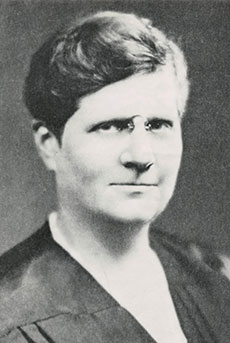
Woman Wins Seat on Court
FLORENCE ELLINWOOD ALLEN
Birthplace: Salt Lake City, Utah
Term: 1923-1934
Five decades after the Reconstruction Amendments, women secured the right to vote when the Nineteenth Amendment to the U.S. Constitution was ratified in 1920. Allen’s friends in the Woman Suffrage Party encouraged her to seek election as a judge on the Cuyahoga County Common Pleas Court. Since the primaries already had been held, the only way to place her name on the statewide ballot was to gather signatures on a petition. In two days, 2,000 signatures were obtained, and she was added to the ballot. Supported by the major Cleveland newspapers, community leaders, and several unions, Allen was elected on Nov. 2, 1920.
In 1922, Allen ran for election to the Ohio Supreme Court. She believed in a nonpartisan judiciary, so she didn’t seek the support of either the Democratic or Republican parties. She again used the petition method to have her name placed on the statewide ballot, and on Nov. 7, 1922, she was elected to the Court.
Allen was the first woman assistant county prosecutor in the United States, the first woman elected to a judicial office in Ohio, the first woman in the nation to be elected to a court of last resort, and the first woman appointed to a federal appeals court judgeship.
Workers' Rights. In 1923, Judge Allen wrote the majority opinion in Ohio Automatic Sprinkler Co. v. Fender. She concluded that the employer’s statutory duty to guard dangerous machinery wasn’t only a common law duty to use all reasonable care to prevent injury to employees, but was a “positive injunction” to guard dangerous machinery. In a 4-3 opinion, the Court, overturning three previous decisions, ruled that these laws were enforceable and employers that willfully violate the law can be sued by employees injured by a machine.
Item of Note: While in law school, Allen supported herself by cataloging French and German legal treatises for the University of Chicago’s library.
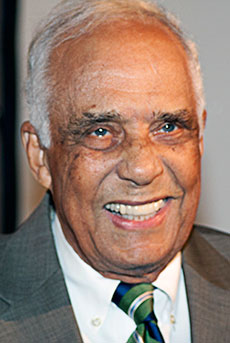
African-American Joins Court
ROBERT MORTON DUNCAN
Birthplace: Urbana, Ohio
Term: 1969-1971
Duncan was appointed to the Ohio Supreme Court in 1969, and won his seat in the 1970 election. A Korean War veteran, he left the Supreme Court in 1971 when he was appointed to the U.S. Court of Military Appeals, the highest court for military personnel.
A jurist of many firsts, Duncan was the first African-American elected to judicial office in Franklin County, the first to serve on the Ohio Supreme Court, the first to win a seat in a statewide Ohio election, the first to serve on the U.S. Court of Military Appeals, and the first to be appointed to the federal bench in Ohio.
As a judge for 11 years on the U.S. District Court for southern Ohio, he heard the Columbus schools desegregation cases in the late 1970s (Penick v. Columbus Board of Education). According to Ohio History Connection, he determined that the Columbus Board of Education knowingly kept white and African-American students apart by creating school boundaries that sent African-American students to predominantly African-American schools and white students to predominantly white schools. Duncan cited evidence that this policy had existed since at least 1909. Although he said the cases weren’t the most difficult he had to decide, given well-established precedent, he described them as the most meaningful.
Item of Note: He referred to his time on the Supreme Court as “[a] monastic life … conducted mostly away from lawyers and litigants … but as exciting as it is exacting.”
Law Schools Claiming Ohio Justices as Graduates
Surveying the law schools that justices hail from reveals a diverse but fairly small mix of institutions, with some clear standouts number-wise.
Of the 20 law schools nationwide that have produced Ohio Supreme Court justices, Ohio State University can tout the most – at 21. In the late 1800s and early 1900s, however, the University of Cincinnati (U.C.) dominated as the nation's first law school west of the Appalachian Mountains. Between 1883 and 1934, nine justices earned law school degrees from U.C., which has picked up four more justices since then.
In third and fourth places are the law schools at Cleveland Marshall (10) and Harvard (8). The University of Michigan ties with Case Western Reserve with six justices each.
Among the law schools in the category of one-is-better-than-none: Cornell, Duke, Georgetown, New York University, Yale, and a favorite because it’s unusual – the Cincinnati YMCA Evening Law School. The school evolved into the Salmon P. Chase College of Law, which is now at Northern Kentucky University.
The country’s first law school, Litchfield in Connecticut, can claim two Ohio Supreme Court justices. But 76 of the Court’s 159 justices had no law degree at all. Instead, as was customary in the early years of the republic, they studied law with a prominent judge or attorney to learn the profession.
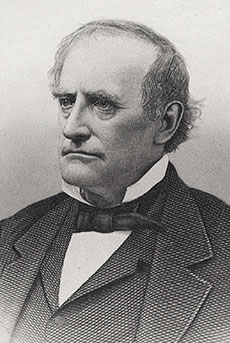
One-Day Jurist
HOCKING H. HUNTER
Birthplace: Lancaster, Ohio
Term: 1864
Hunter studied law under the guidance of a former Ohio Supreme Court judge, William W. Irvin, and was admitted to the bar in 1824.
During the Civil War, Hunter supported the Union cause and was elected to the Supreme Court in 1863. According to a 1991 article about Supreme Court portraits, Hunter was sworn in to the Court on Feb. 9, 1864, at 10 a.m. and resigned at either 1 p.m. or 4 p.m. When he realized he couldn’t both serve as judge and maintain his law practice, he left the Court.
Two of Hunter’s children pursued legal careers – Edward became a judge in Seattle, Washington, and John served as Utah’s chief justice.
Item of Note: The Hunters were among the earliest white settlers of Fairfield County.
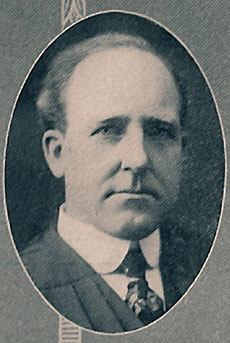
Nearly Four-Decade Tenure
EDWARD SHILOH MATTHIAS
Birthplace: Gilboa, Ohio
Term: 1915-1953
His almost 39-year term on the Ohio Supreme Court makes Matthias the longest-serving member in Court history. Elected in 1914, his term spanned from Jan. 1, 1915, to Nov. 2, 1953.
Matthias held positions as common pleas judge and appellate court judge before his election to the Court, and estimates indicate he heard more than 30,000 cases during his career on the bench. He is thought to have written more than 1,000 opinions as a Supreme Court judge. Thirty-three other Supreme Court judges served with him.
Item of Note: Matthias didn’t complete his last term because he died in an accidental fall while doing home repairs. His son, John M. Matthias, was chosen to complete his father’s term.
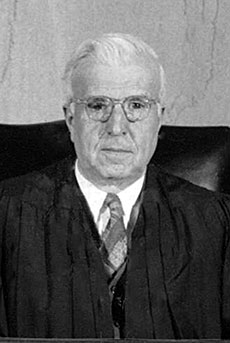
Longest-Serving Chief Justice
CARL VICTOR WEYGANDT
Birthplace: Near Wooster, Ohio
Term: 1933-1962
Weygandt served for 38 years on the state’s courts, including 30 years as chief justice of the Ohio Supreme Court. He holds the longest tenure as a Supreme Court chief justice.
In 1954, during his fourth term on the Court, Weygandt was frustrated because he was unsuccessful in persuading the legislature to raise judicial salaries or to establish a judicial pension plan, and he submitted his letter of resignation to the governor. The governor held on to the letter, but didn’t accept the resignation. One month later, Weygandt reconsidered and agreed to stay on the high court.
Items of Note: His biography describes Weygandt as a jurist worthy of the movies, noting his “tall erect frame, silver hair, excellent speaking voice, and pince-nez eyeglasses.” Weygandt also earned national recognition as an outstanding football official and expert on the rules of the game.
Repeating Names
Certain surnames of justices have shown up more than once in the Supreme Court’s history. Brown sits far ahead of any other, with eight Court members who had that name. The photos show the *first judge or justice who served on the Court with a particular surname, along with the number of times that name has appeared.
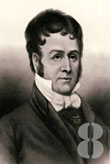
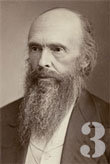
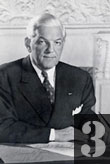
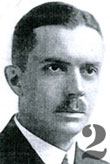
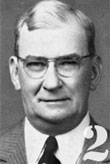
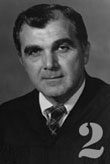
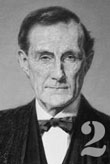
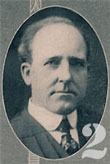
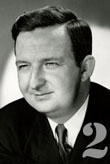
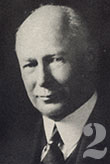
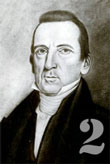
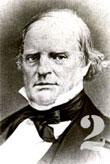
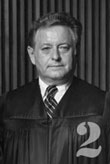
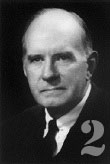
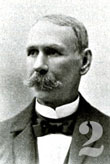
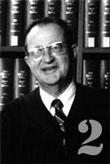
*The first judge or justice with an available photo was presented here.
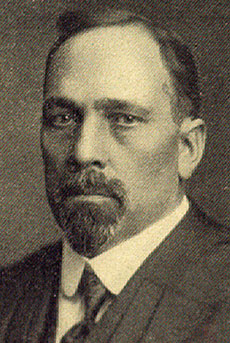
Chronicler of Court History, International Jurist
CARRINGTON TANNER MARSHALL
Birthplace: Near Zanesville, Ohio
Term: 1921-1932
The first public office Marshall held was chief justice of the Ohio Supreme Court. After 12 years guiding the Court, he edited “A History of the Courts and Lawyers of Ohio,” published in 1934. The four-volume set describes the evolution of Ohio’s courts, the history of the state constitution and important statutes, legal precedents, and biographies of noted jurists and lawyers.
In February 1947, he was appointed as a judge at the Nuremberg war-crimes trials, which prosecuted Nazi war criminals in Nuremberg, Germany, after World War II. He presided over the trial of German lawyers and judges. Due to serious illness, Marshall had to resign in June 1947 and returned to Ohio.
A published memorial stated, “Chief Justice Marshall and his associates were charged with the responsibility of deciding many constitutional questions which would vitally affect the State for many generations.”
Item of Note: According to a brief biography of Marshall, the Court, under his leadership, became known for its prompt hearings and decisions, and for citations by other courts to its rulings.
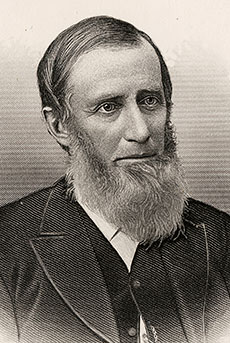
Career of Public Service
PETER MARSHALL HITCHCOCK
Birthplace: Cheshire, Connecticut
Terms: 1819-1833; 1835-1842; 1845-1852
Hitchcock served for nearly 30 years on the Ohio Supreme Court, 21 of those as chief judge. The terms, though, weren’t continuous. The Ohio General Assembly elected Hitchcock to the Court in 1819, and he served two terms until the legislature declined to re-elect him in 1833. The legislature again chose Hitchcock for the Court in 1835, refused to re-elect him in 1842, but returned him to the Court in 1845.
He decided not to seek popular election to the Court under Ohio’s 1851 Constitution, although he favored the direct election of judges as well as the state’s lieutenant governor, auditor, treasurer, secretary of state, and attorney general.
Having served in the Ohio House of Representatives, Ohio Senate, and U.S. Senate, the two years from 1843 to 1844 marked the longest period that Hitchcock didn’t hold some type of public office.
Water Rights. One of Hitchcock’s most cited opinions addressed a lawsuit from property owners living along the Mad River near Dayton. They alleged that the government was diverting too much water from the river to serve a public canal. In 1832, the Supreme Court ruled in Cooper v. Williams that the government hadn’t withdrawn an excessive amount of water from the river. Hitchcock wrote, though, that the property owners do have the same right to use the water flowing through their land as they do to the land itself. Had there been an improper taking of their water usage, they would be entitled to be compensated by the government, he noted.
Item of Note: Ohio has significant ties to Connecticut, where a few of the state’s Supreme Court judges were born. Connecticut had land claims in the “Ohio Country” going back to the Colonial period. According to Ohio History Connection, when Connecticut relinquished most of its claims to the land to create the Northwest Territory, the state kept what is now the northeast corner of Ohio, which became known as the Connecticut Western Reserve. In the early years of settlement, many people from New England came to the Western Reserve.
Learn More
Want more details about the Ohio Supreme Court and its justices? The Court’s Law Library, which was essential to compiling this article, is at your service. And check out the Visitor Education Center to learn more about the Court.
Credits
Background on individual judge and justice photos: Mariia Vasileva/Thinkstock; background on "Historical Background": littleclie/Thinkstock; golden frame: Misao NOYA/Thinkstock.
